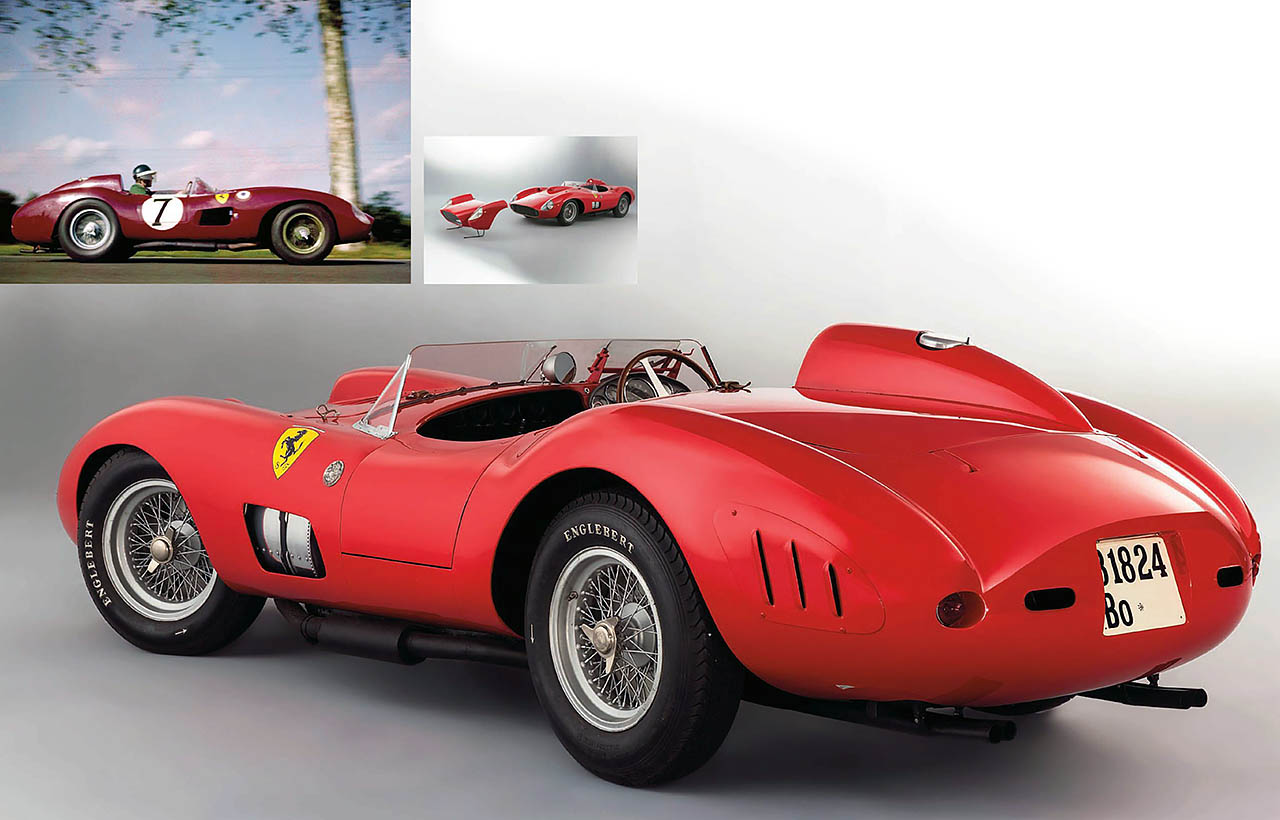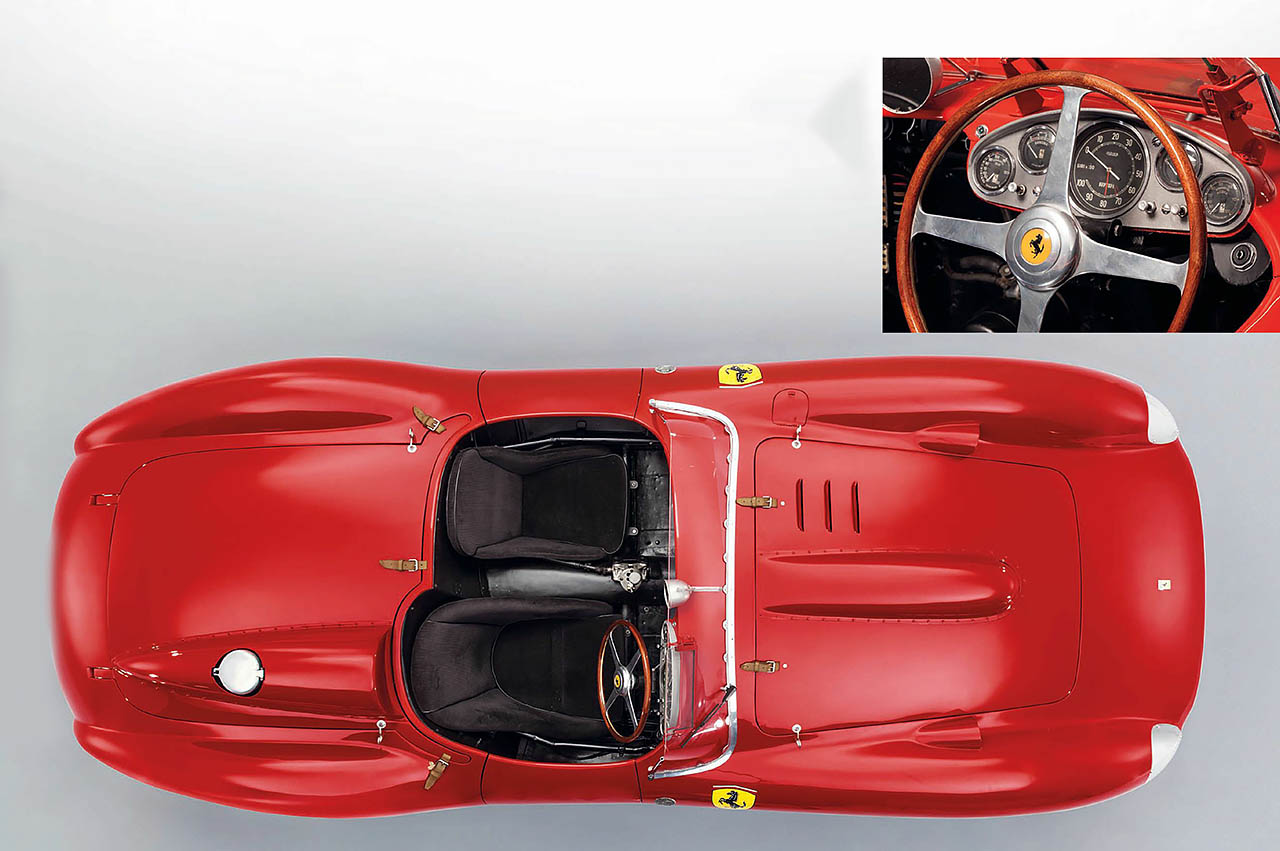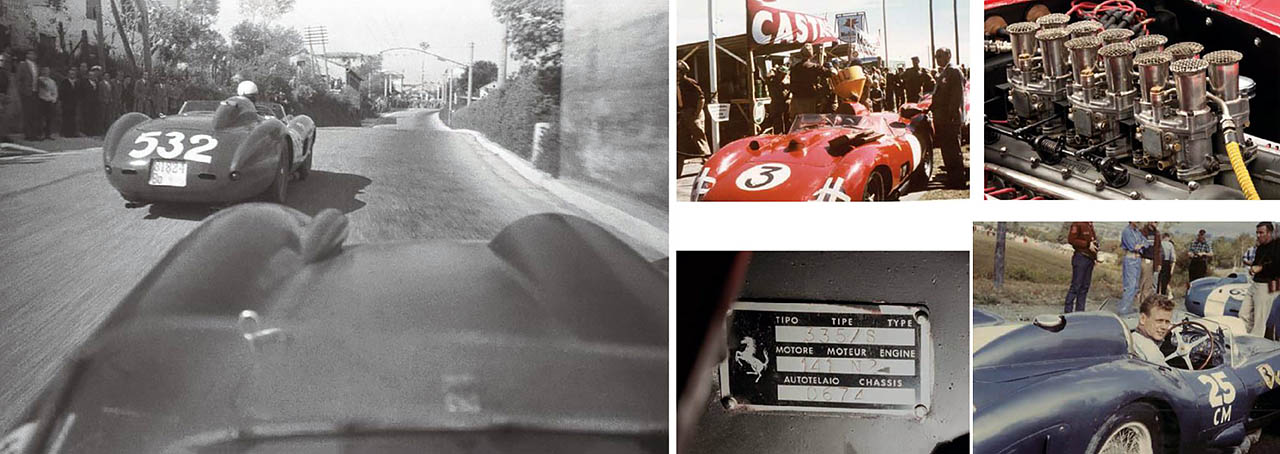
The Greatest Ferrari Ever? For sheer beauty and pace, few cars can rival the Ferrari 315/335S. Better than a Testa Rossa Mick Walsh tells the story of the ex-Pierre Bardinon Ferrari 315/335S. Developed for the ’1957 world championship, the 315/335S may well deserve that accolade, says Mick Walsh. Photography Christian Martin/Klemantaski Collection/Rickard Bruzelius.
For epic eras of motorsport, the 1957 sports car championship sits up there with the pre-war 750kg titans, Formula 1’s turbo years and Group B’s rally rockets. With unlimited-capacity engines powering aluminium-bodied beauties driven by all walks of hotshoe – ranging from European aristocrats to upstart Americans – the series played out dramatically from Florida to Caracas. Sadly, tragedy mid-season on the Mille Miglia was the last straw for the ultimate development of these superfast, front-engined two-seater greats. The rarest, most exotic and today the most prized of the 1957 contenders is Ferrari’s little-seen four-cam V12 315/335S.

To match the brutal power of the potent V8 in Maserati’s 450S, Ferrari had to produce something special, and the timely acquisition of the Lancia racing team – with which came the talent of Vittorio Jano – led to the development of its first four-cam motor. Key engineers were Vittorio Bellentani, Alberto Massimino and Andrea Fraschetti, but the Alfa legend was the catalyst. The V12 Tipo 130 block was not radically modified, but new heads were developed with two camshafts per bank driven by triplex chains. Valves were 35mm for inlet and 29mm for exhaust, and operated by mushroom-headed tappets with twin concentric helical springs. Twenty-four plugs were squeezed into the middle of the two 60° vees, with a huge 12-point distributor sprouting from the back of each head.
Various carburettor set-ups were tried, including six 42 DCM Webers, but a trio of four-choke Solex C 40P IIs gave the smoothest power. The first four-cam, the Tipo 136, appeared in the 290 Sport, while in its ultimate specification – the Tipo 141, with capacity increased to 4023cc – this fantastic motor eventually delivered 390bhp at 7800rpm. “It wasn’t just the amount of power that mattered, but the quality of that power,” recalled Phil Hill in 1990. “This engine had a beefier supply of ‘oomph’ that went beyond just the displacement increase over the two-cam, 3-litre Testa Rossa. These big V12s seemed to have an even greater willingness to rev, and had considerably more torque at the bottom end.”
The tubular chassis was a development of the Type 520 from 1956, with a 2350mm wheelbase but lowered to stiffen the main cross-section. The classic design featured wishbones and coil springs at the front, while the de Dion rear featured a transverse leaf set-up plus a hefty fourspeed transaxle gearbox with the clutch up front. Despite the increased power, Ferrari persisted with enormous, well-ventilated drum brakes. The bodies were hammered out by Scaglietti’s brilliant artisans. The result, with its aggressive, wide grille and muscular, hunched rear, looked both voluptuous and forceful. Only five were built, with one destroyed in playboy Alfonso de Portago’s horrific Mille Miglia crash.
The featured car – chassis 0674 – made its debut in the Sebring 12 Hours as a Type 315S with 3.8-litre motor, Peter Collins teaming up for the drive with Maurice Trintignant. After setting the pace from the start, they were plagued with brake and tyre problems and eventually finished sixth in a race dominated by Maserati.
For the Mille Miglia, blue-blooded German racer Wolfgang von Trips took over ‘0674’ as part of a determined works assault by Ferrari, with a quartet of ‘four-cams’ entered. Trips spoke little Italian and had no mechanical knowledge – he carried a camera in the cockpit to take photos if he broke down – so wasn’t a race favourite. Peter Collins set the pace early on, with von Trips running third on the leaderboard.
Although no match for the victorious ‘Silver Fox’ Piero Taruffi, the German count trailed the Italian across the line in second place. When Taruffi’s 315S suffered gearbox problems, Enzo instructed von Trips to hold back from engaging in a battle that might eliminate both cars. “Between Cremona and Mantua,” recalled Taruffi, “Wolfgang passed me, and I had to drive full out to overtake him again, which persuaded him to stay put until the finish in Brescia.” When the sketchy news filtered through of de Portago’s crash, the celebrations quickly cooled. Such roadracing madness had long been on borrowed time, and the last Mille Miglia had been run. These ferocious, 180mph machines driven by GP aces were just too fast for the public highway.
The 315S/335S was no match for Tony Brooks’ Aston Martin around the Nordschleife for the Nürburgring 1000km, Road & Track’s headline ‘British dentist pulls German and Italian teeth’ saying it all. For Le Mans, though, ‘0674’ was back with the engine uprated to 4.1 litres for Mike Hawthorn. Fangio’s Maserati 450S took pole, but during the race the Ferraris set a blistering pace, Collins rocketing away to put in a record first lap. The V12 would cry enough, however, after just two more. Hawthorn took over the lead and set a sensational fastest lap of 3 mins 59.6 secs, breaking the 200kph barrier for the first time. That record would stand for the next five years, but after just 56 laps the Englishman’s engine also failed.
Maserati ruled at the Swedish GP at Råbelöfsbanan, Kristianstad, where ‘0674’ – driven by Hawthorn and Luigi Musso – finished fourth. In September, the body was modified by Scaglietti to a ‘pontoon’ style in an attempt to improve brake cooling for the final race of the season in Caracas. With the championship still wide openbetween Ferrari and Maserati, the climax around the city circuit couldn’t have been more dramatic.
Fires and tyre blowouts left the Trident team decimated and Maranello victorious, Hawthorn/ Musso in ‘0674’ following Collins/Hill home, while a brace of 250TRs completed a dominant 1-2-3-4 Ferrari win to end this spectacular era. The by then redundant ‘0674’ was sold to Luigi Chinetti, and Maserati ace Stirling Moss – who drove few front-engined Ferraris – was entered by NART for the dramatic Cuban Grand Prix. The Havana event is best known for the kidnapping of Juan Manuel Fangio, but the race was shortened after Armando García Cifuentes tragically spun off into the crowd.
Moss nipped past leader Masten Gregory under red flags to take the win, but sportingly agreed to split the prize money with the American. “I really enjoyed those beautifully smooth, powerful and reliable engines,” recalled Moss, who insisted the centre throttle be switched to the right before racing the Ferrari. “The 335S had a lot of power and, despite being rather heavy to handle, it was well suited to the fast Havana street circuit. After three straight Ferrari wins (two of them at Nassau), it was clear why the works cars were so hard to beat.”
With the new 3-litre limit for Europe, the only market for the 335S was America. Chinetti displayed the car – painted blue with a white stripe – at the Franklin Hotel in New York, and eventually Mike Garber acquired it to run in SCCA events with Gaston ‘Gus’ Andrey driving. Highlight of the season was a win in the Road America 500, Scarab founder Lance Reventlow sharing the wheel on the fast Elkhart Lake circuit in Wisconsin, where the 335S trounced a strong field of Testa Rossas and Listers.
After just two seasons of racing, the tattylooking ‘0674’ was sold by Garber to Robert Dusek, an architect based in Solebury, Pennsylvania. Dusek had the foresight to save many great Ferraris and, when the famous French collector Pierre Bardinon switched from his first love of Bugattis to Maranello’s finest, he was soon in contact with the American.
Bardinon, who had a private track around the grounds of his home, built up one of the world’s greatest Ferrari collections, including four Le Mans winners. With wealth from the family leather business – Chapal supplied flying jackets to the USAF during WW2 – the highly knowledgeable Bardinon sought out the finest and most famous racing cars. High on the list was the legendary ‘four-cam’ that he’d seen Hawthorn gun to a record lap at Le Mans in 1957. The French collector never visited America, leaving his deals to trusted specialists, but in 1970 Dusek eventually gave in to the persistent offers.
Back in France, Bardinon’s team researched the car, and eventually sent it to Carrozzeria Fantuzzi in Modena to be restored. The ‘pontoon’ nose was changed back to the original style, and the body repainted red. A wine connoisseur, Bardinon claimed that the 335S was a cru exceptionnel and the finest front-engined Ferrari. He even designed his circuit so that it suited the drum brakes of the older cars, regularly taking the 335S out for test runs. When marque historian Antoine Prunet selected 30 top models for his superb book Fantastiques Ferraris, the 335S was high on the list.
Bardinon remained a discreet but generous collector who regularly invited clubs and enthusiasts to his track, but ‘0674’ rarely left the gates of the private museum. Special outings included the Cartier Hommage à Ferrari in 1987, and the 50th-anniversary celebrations in Rome in 1997. Such was the respect for the French collection that, when Enzo was once asked why he had never created a factory museum, he responded: “There’s no need, Bardinon has done it for me.”
After a long illness, the Frenchman died aged 73 in 2012, and slowly his Ferraris – including a 250GTO – were sold off by his children. Heavy death duties have now forced the sale of his favourite 335S, and it’s tipped to break the auction record for a collector’s car at Rétromobile. Few have driven a 335S more than American collector Peter Sachs. The owner of sister car ‘0700’, which made its debut on the Mille Miglia with Peter Collins and legendary photographer Louis Klemantaski, Sachs has driven extensively on road and track since acquiring it in 1991.
Highlights have included re-running the Mille Miglia course with the 79-year-old snapper gamely riding shotgun again. “Louis was a young person at heart,” says Sachs, who now owns the Klemantaski archive, “and kept referring to the 335S as ‘my car’. His memory was fantastic. We discovered a colour shot taken on the Adriatic coast route. You can clearly see the tacho at 7500rpm, which in fourth is 180mph.”
Collins was the quickest of the team in the 1957 race and on a fast but winding stretch near Ancona caught von Trips, who’d started two minutes ahead at Brescia. “I don’t know whether he did it on purpose but we could not get past. He was weaving in front,” recalled Klemantaski in Road & Track. “Peter was flashing the lights.
I was blowing the horn but he took no notice. At last I was able to give Peter a signal that the next corner was a fast one, even though it didn’t look it. Von Trips slowed slightly and we out-braked him and got past, then just pulled away.” Collins was on determined form and reached Rome 5 mins ahead of his closest rival – and just 6 secs short of Moss’ 1955 record – but frustratingly the differential failed in Parma.
“It’s challenging to drive fast on the road, particularly the heavy gearbox, but on a fast track it’s completely different,” says Sachs, who raced ‘0700’ everywhere from Laguna Seca to Silverstone. “The engine is very complex but delivers turbine acceleration. This is due to the Solexes, which, unlike Webers, have no accelerator pumps: when you get on the power, it’s very smooth. Into corners it’ll understeer slightly, but you can set up a lovely drift once past the apex. Out of corners it goes like stink and at Elkhart Lake we clocked 175mph down the main straight. It’s a fabulous car and very easy to drive fast. Around Elkhart it was 4 secs quicker than my GTO.”
As with most front-engined Ferrari sports racers, the driving position comes in for criticism from Sachs: “It has the classic ‘orang-utan’ seating with upright back, knees up high, and arms splayed out. I understand that Hawthorn had ‘0674’ modified with a rail behind the seat moved to give an extra two inches. The ’box has a firm action but we’ve fitted a modern clutch instead of the original diaphragm, which helps. The brakes are pretty good. Very predictable with no hunting but you are on them before anyone with discs. We do all our work ‘in house’ and it’s been very reliable. The 335S is a terrific car and, for me, the best front-engined Ferrari.” Back in 1990, Phil Hill stated in Road & Track that with a fantasy lottery win, he would buy a 335S. “People talk about how wonderful the Testa Rossa sounds – and they do – but these four-cammers were of another order altogether,” he said. He should know, because he raced both: “The 335S exemplified the sort of racing I liked best. Just you and a very powerful unblown engine in a chassis no better than that engine, the driver working like hell to get to the finish first.”
That ’57 season was part of an heroic era, so I hope the new owner has the passion to drive this Ferrari hard. The idea of that V12 never roaring at heady revs again is really disheartening.
Thanks to Artcurial: www.artcurial.com
‘OUT OF CORNERS IT GOES LIKE STINK, AND AT ELKHART LAKE WE CLOCKED 175MPH’

Clockwise, from above: evocative Klemantaski shot of Hawthorn blasting out of Tertre Rouge at Le Mans in 1957; nose was returned to original spec during 1981 restoration but ‘pontoon’ front was saved; sublime tail styling.

Clockwise, from above: ‘0674’ as raced by Gaston Andrey in 1958, painted in NART team colours and with modified ‘pontoon’ nose; distinctive and more rigid four-spoke steering wheel as requested by Hawthorn in favour of the usual three-spoker; bird’s eye view of magnificent Scaglietti-built bodywork.

Quad-cam V12 breathes through triple four-choke Solex carburettors. Twinplug ignition with dual distributors and four coils means a mass of HT leads.

Clockwise: the moment Collins caught von Trips on the Mille Miglia, captured by Klemantaski; original chassis plate; refuelling at Råbelöfsbanan during the 1957 Swedish GP; Solex carbs give smooth power.
‘TO MATCH THE BRUTAL MASERATI V8, FERRARI HAD TO PRODUCE SOMETHING SPECIAL‘






